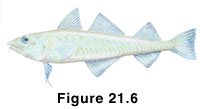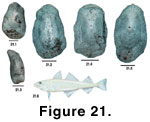 Description
DescriptionMicrogadus proximus
(Pacific Tomcod)
(Other common names: Wachna)
Figure 21.6
 Description
DescriptionLength: 30 cm.
Mouth: moderate, terminal; directed slightly upwards; maxillary extends to mid-pupil; teeth in bands on jaws and vomer; outer row enlarged; lateral line high anteriorly, dipping mid-body.
Body: elongate and tapers towards caudal fin; three separate and spineless dorsal fins, two anal fins; caudal fin truncate; chin barbel is about equal to pupil diameter; anus below first dorsal fin.
Color: olive green on dorsal; creamy white below; dusky fin tips.
Depth: up to 220 m; young in shallower waters.
Habitat: generally benthic on sandy substrate.
Season: spawn in winter; eggs hatch in from 8 to 17 days depending on temperature (citation in Hart, 1973).
Diet: shrimps, small crustaceans; worms, mollusks.
Predators: seals and sea lions, Scombridae, hake.
Distribution: southern California to Alaska to the Bering Sea; in BC not abundant.
 Scale
Description
Scale
DescriptionRelative Scale Size: small but size is variable not only across the body but within sampling areas.
Scale Position on the Body: not determined.
Overall Shape: the scale varies from semi-circular to oval and the leading edges of the fields can appear distorted (this can be exaggerated depending on how desiccated the scale is).
Focus and Circuli: the focus is not centralized between the four fields and is approximately one-third of the total length from the anterior margin. The exception in this collection is the C scale. This is a more rounded circular scale, and the focus is centralized. The circuli are generally continuous but in the leading edges of the fields, they can be distorted or broken by the intermarkings.
Radii: there are no radii, however, there are distinct intermarkings (sensu Batts, 1964), which are perpendicular or irregular "lines/structures" between the circuli. These intermarkings can align between the circuli to give a loosely similar appearance to radii.